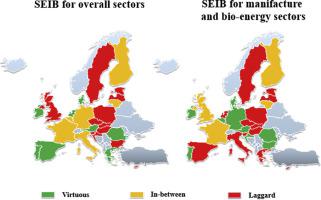当前位置:
X-MOL 学术
›
Ecol. Econ.
›
论文详情
Our official English website, www.x-mol.net, welcomes your
feedback! (Note: you will need to create a separate account there.)
A New Socio-economic Indicator to Measure the Performance of Bioeconomy Sectors in Europe
Ecological Economics ( IF 6.6 ) Pub Date : 2020-10-01 , DOI: 10.1016/j.ecolecon.2020.106724 Idiano D'Adamo , Pasquale Marcello Falcone , Piergiuseppe Morone
Ecological Economics ( IF 6.6 ) Pub Date : 2020-10-01 , DOI: 10.1016/j.ecolecon.2020.106724 Idiano D'Adamo , Pasquale Marcello Falcone , Piergiuseppe Morone

|
The European Commission supports the production of renewable biological resources and their conversion into value added products and bio-energy. A new bioeconomy strategy aimed at promoting a sustainable Europe was launched in October 2018. However, little work has been done to monitor, model and appraise the impacts and developmental trajectories of bioeconomy sectors. To gauge the current sustainability performance of individual European countries, the present study proposes a new indicator – the “socio-economic indicator for the bioeconomy” (SEIB) – to measure the socio-economic performance of bioeconomy sectors. Drawing on Eurostat data and the analytic hierarchy process, multi-criteria decision analysis is employed with the aim of providing a direct comparison between member states (MSs). However, bioeconomy involves a large number of sectors and, therefore, it is useful to propose two versions of this indicator in order also to single out the impact of most innovative sectors: the first version considers all bio-based sectors (“SEIB for overall sectors”) while the second version excludes all primary sectors (“SEIB for manufacturing and bio-energy sectors”). The results identify three groups of MSs (virtuous, in-between and laggard) with reference to the European average. Ireland occupies the first position in the ranking, and only three other MSs (Denmark, Portugal and Austria) qualify as “virtuous” countries in both rankings.
中文翻译:

衡量欧洲生物经济部门表现的新社会经济指标
欧盟委员会支持可再生生物资源的生产并将其转化为增值产品和生物能源。旨在促进可持续欧洲的新生物经济战略于 2018 年 10 月启动。然而,在监测、建模和评估生物经济部门的影响和发展轨迹方面几乎没有做任何工作。为了衡量单个欧洲国家当前的可持续发展绩效,本研究提出了一个新指标——“生物经济的社会经济指标”(SEIB)——来衡量生物经济部门的社会经济绩效。借鉴欧盟统计局的数据和层次分析法,采用多标准决策分析,旨在提供成员国 (MS) 之间的直接比较。然而,生物经济涉及大量部门,因此,提出该指标的两个版本是有用的,以便也能挑出大多数创新部门的影响:第一个版本考虑所有基于生物的部门(“整体部门的 SEIB”) ) 而第二个版本不包括所有初级部门(“制造业和生物能源部门的 SEIB”)。结果参照欧洲平均水平确定了三组 MS(良性、中间和落后)。爱尔兰在排名中位居第一,其他三个国家(丹麦、葡萄牙和奥地利)在这两个排名中都被评为“良性”国家。第一个版本考虑了所有基于生物的部门(“SEIB 整体部门”),而第二个版本排除所有初级部门(“制造和生物能源部门的 SEIB”)。结果参照欧洲平均水平确定了三组 MS(良性、中间和落后)。爱尔兰在排名中位居第一,其他三个国家(丹麦、葡萄牙和奥地利)在这两个排名中都被评为“良性”国家。第一个版本考虑了所有基于生物的部门(“SEIB 整体部门”),而第二个版本排除所有初级部门(“制造和生物能源部门的 SEIB”)。结果参照欧洲平均水平确定了三组 MS(良性、中间和落后)。爱尔兰在排名中位居第一,其他三个国家(丹麦、葡萄牙和奥地利)在这两个排名中都被评为“良性”国家。
更新日期:2020-10-01
中文翻译:

衡量欧洲生物经济部门表现的新社会经济指标
欧盟委员会支持可再生生物资源的生产并将其转化为增值产品和生物能源。旨在促进可持续欧洲的新生物经济战略于 2018 年 10 月启动。然而,在监测、建模和评估生物经济部门的影响和发展轨迹方面几乎没有做任何工作。为了衡量单个欧洲国家当前的可持续发展绩效,本研究提出了一个新指标——“生物经济的社会经济指标”(SEIB)——来衡量生物经济部门的社会经济绩效。借鉴欧盟统计局的数据和层次分析法,采用多标准决策分析,旨在提供成员国 (MS) 之间的直接比较。然而,生物经济涉及大量部门,因此,提出该指标的两个版本是有用的,以便也能挑出大多数创新部门的影响:第一个版本考虑所有基于生物的部门(“整体部门的 SEIB”) ) 而第二个版本不包括所有初级部门(“制造业和生物能源部门的 SEIB”)。结果参照欧洲平均水平确定了三组 MS(良性、中间和落后)。爱尔兰在排名中位居第一,其他三个国家(丹麦、葡萄牙和奥地利)在这两个排名中都被评为“良性”国家。第一个版本考虑了所有基于生物的部门(“SEIB 整体部门”),而第二个版本排除所有初级部门(“制造和生物能源部门的 SEIB”)。结果参照欧洲平均水平确定了三组 MS(良性、中间和落后)。爱尔兰在排名中位居第一,其他三个国家(丹麦、葡萄牙和奥地利)在这两个排名中都被评为“良性”国家。第一个版本考虑了所有基于生物的部门(“SEIB 整体部门”),而第二个版本排除所有初级部门(“制造和生物能源部门的 SEIB”)。结果参照欧洲平均水平确定了三组 MS(良性、中间和落后)。爱尔兰在排名中位居第一,其他三个国家(丹麦、葡萄牙和奥地利)在这两个排名中都被评为“良性”国家。









































 京公网安备 11010802027423号
京公网安备 11010802027423号